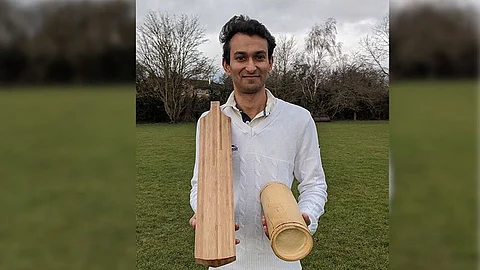

The cricketing world should consider switching from willow to bamboo as an alternative for cricket bats because high performance, low-cost production and increased sustainability could make bamboo cricket bats a viable and ethical alternative to willow, according to new research from the University of Cambridge.
The study, by academics Darshil Shah, Ben Tinkler-Davies and Michael Ramage published in ‘The Journal of Sports Engineering and Technology’, claims that bamboo is significantly stronger than willow and able to hold much higher loads, meaning that bats made with bamboo could be thinner while remaining as strong as willow. The researchers found that the so-called sweet-spot on their prototype bamboo blade performed 19 per cent better than that on a traditional willow bat.
“This is a batsman’s dream,” co-author Dr Darshil Shah, a former member of Thailand’s under-19 national cricket team, told the University of Cambridge.
“The sweet-spot on a bamboo bat makes it much easier to hit a four off a Yorker for starters, but it’s exciting for all kinds of strokes. We’d just need to adjust our technique to make the most of it, and the bat’s design requires a little optimisation too,” said Shah, from the Centre for Natural Material Innovation, Department of Architecture at the University of Cambridge.
Microscopic analysis
His team compared the performance of specially made prototype laminated bamboo cricket bats, the first of their kind, with that of typical willow bats. The investigations included microscopic analysis, video capture technology, computer modelling, compression testing, measuring how knocking-in improved surface hardness, and testing for vibrations.
During manufacture, the surface of cricket bats is compressed to create a hardened layer. When the team compared the effect of this "knock-in" process on both materials, they found that after five hours bamboo’s surface hardness had increased to twice that of pressed willow.
The authors of the study also tested for comfort and found that bamboo had a similar “damping ratio” to willow meaning that a similar amount of force is transferred to a player’s hands when they strike the ball. In other words, players using bamboo bats wouldn’t feel any more vibration than if they tried out a willow bat.
Eco-friendly option
The research also highlights that there is a shortage of good-quality willow, which takes up to 15 years to mature – mostly in England – to the point where the wood can be used to make cricket bats. Even then, bat makers often have to throw away a large quantity (up to 30 per cent) of the wood they source.
By contrast, Moso and Guadua, the two most suitable types of structural bamboo, grow abundantly in China, across Southeast Asia and South America. These bamboos mature twice as fast as willow and because the cell structure in the laminated material is more regular, less raw material is wasted during manufacture.
“Cricket brings you really close to nature, you spend hours out in the field, but I think the sport can do a lot more for the environment by promoting sustainability. We’ve identified a golden opportunity to achieve that while also helping lower income countries to produce bats at lower cost,” said Tinkler-Davies, from the Department of Engineering at Cambridge.
Working with a local cricket bat manufacturer, Garrard & Flack, the researchers created a full-size bamboo bat prototype for the purpose of the research.